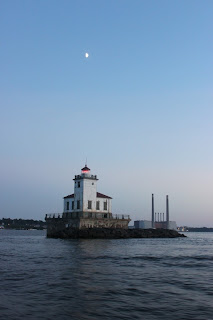The Rideau Canal, after departing metropolitan Ottawa, is all about winding channels interspersed with broad lakes, small villages, shores lined with trees and farmland, all tied together by a series of 46 locks still operating as they were built in the 1830s. I believe it is the most peaceful and enchanting cruising ground we have been on to date. We did seven more locks today, which seems like a lot, but they are a major part of the character and history of this region and a part of the cruising lifestyle here.
The day started with cutting a hundred pounds of seaweed off the anchor with a long serrated knife. The grasses grow very heartily here on the bottom of the shallow waters. Our first challenge came as we encountered the Brass Point Swing bridge and were told it had broken last night and they were waiting for a repair team to arrive. After dropping the anchor, I swam to cool off. Fortunately, workmen soon arrived and had the bridge open about an hour later. What a relief as we had visions of being here days (as in the Erie Canal)!
 |
| Larry cutting seaweed off the anchor |
 |
| The Brass Point Swing Bridge |
As a curious engineer, one more thing I observed about the locks is that there are three different systems in use for opening the doors. The most common is a long wooden pole attached to the door, with a winch using chains attached to each end to pull the door open and in reverse push it shut. Much less common is an extension of the door out over the land, with a winch and chains pulling or pushing on it to open/shut the door. Very rarely, the door is controlled by a winch, with a cable over to the door for opening, and another strung down the lock wall under the water and over to a pulley on the door for closing. This last type was needed where space was a premium, but suffered from weeds and debris getting tangled in the cables. We entered the Kingston locks, which is the only set where all three types can be seen.
 |
| The Kingston Lock and Military Blockhouse |
 |
| Pole style door opening |
 |
| Swing arm style door opening |
 |
| Cable style door opening |
We arrived at 3:00 p.m. at the end of the canal in Kingston, Ontario, and found ourselves three weeks behind our original overall plan to start through the Trent/Severn Canal to Lake Huron. There is no way we can be home in two weeks to be with our daughter and meet commitments we made for the month of August, so our new plan is to store the boat in Brewerton, New York and come back next June for a leisurely completion of the Great Loop. It is a difficult but necessary decision, as we had envisioned crossing our wake this year and having a major celebration party.
The weather over Lake Ontario was showing increasing wave heights and thunderstorms are approaching over the next few days. So in order to avoid more Eric Canal-type delays, we decided not to stop in Kingston but keep going even though it was another 55 miles. This would put us in Oswego to clear customs at 9:30 p.m. and stay overnight at the Oswego Marina.
 |
| Wolfe Island, Ontario lighthouse |
 |
| Oswego, NY harbor entrance lighthouse |
 |
| Sunset over Lake Ontario and Canada |
As we docked it was dark, and we were tired. Backing into the slip I heard a yell for help from Anne, rushed back to the cockpit, and discovered she had fallen backwards off the narrow high dock! Luckily, there was a ladder in that empty slip, and she crawled out wet, embarrassed, and with a nasty bruise and some minor scratches. We were both relieved as it could have been a more serious event.






















































